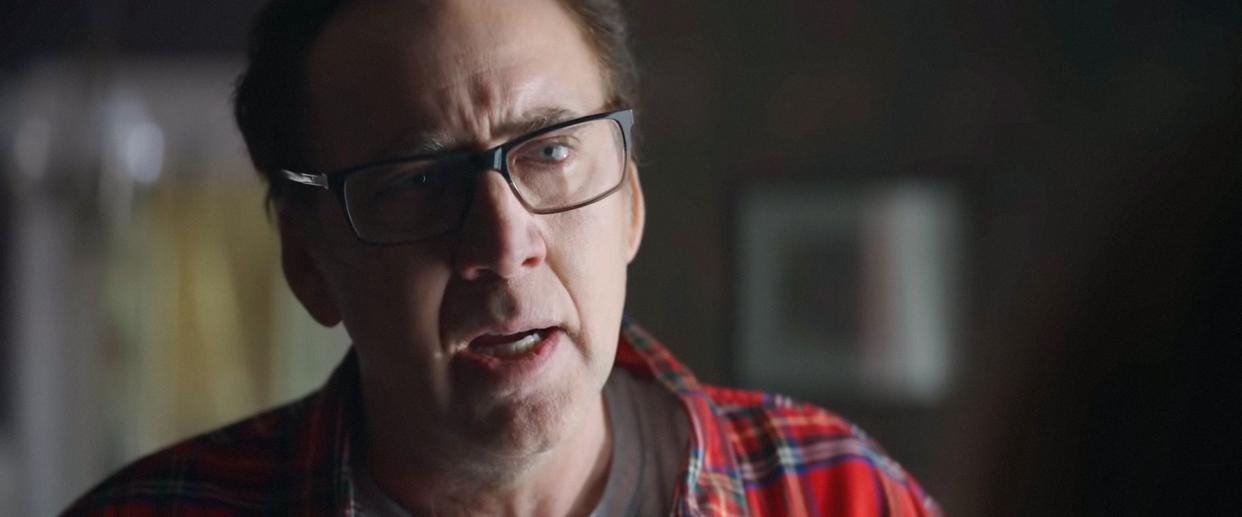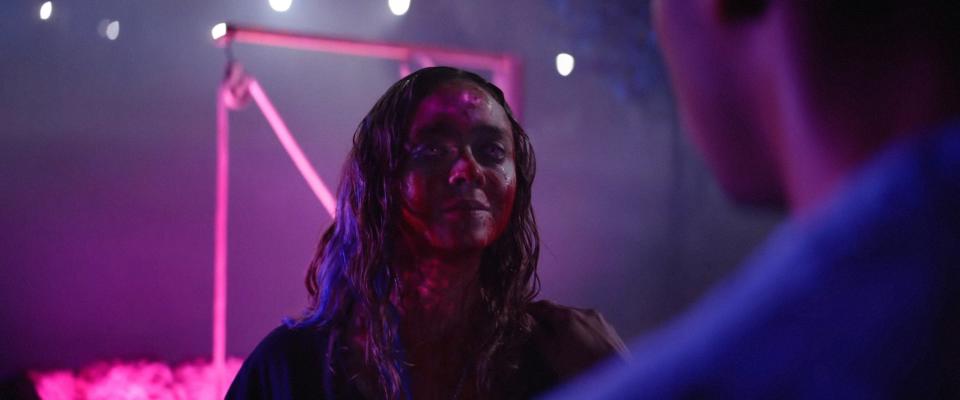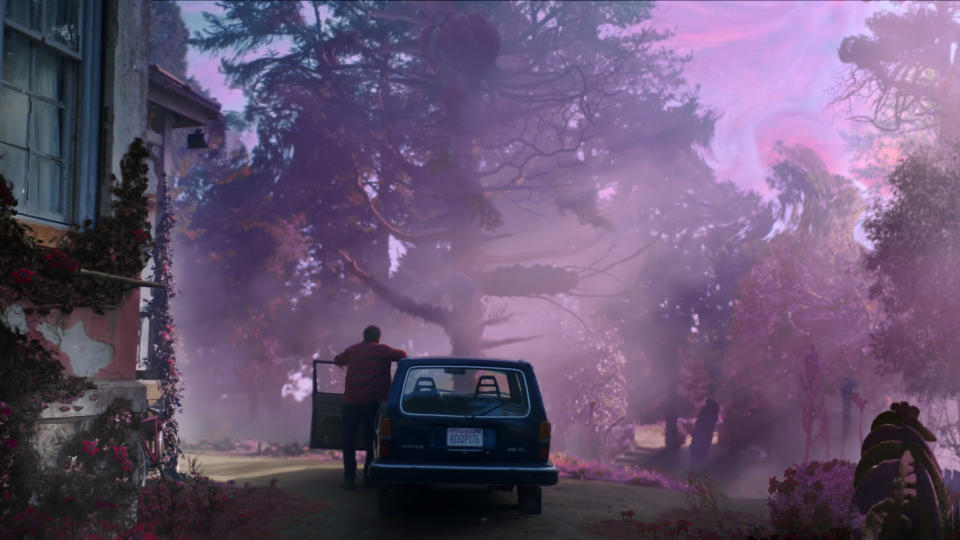Why a pointed Trump critique and Nic Cage doing handstands were cut from the actor's new horror movie 'Color Out of Space'

Here are some of the strange sights you’ll witness in Nic Cage’s latest cult horror movie Color Out of Space: the National Treasure star ranting about alpacas and messily chowing down on tomatoes; Joely Richardson mutating into a monster that resembles a festering sore; and an unearthly shade of not-quite purple that unleashes other horrors after a strange meteorite falls from the stars to terra firma. But here’s what you won’t see in the H.P. Lovecraft-inspired film, which opens in theaters this weekend after premiering at the Toronto International Film Festival last fall: an intense scene of teenage self-harm, and a pointed reference to President Donald Trump. Writer-director Richard Stanley had to cut both of those moments out of the finished feature at the behest of the film’s producing team. “It was a feisty post-production process,” the South African-born filmmaker confessed to Yahoo Entertainment at TIFF. “So many of my favorite bits were taken out.”
And Stanley has experienced “feisty” sets before: he was famously fired one week into shooting 1996’s The Island of Dr. Moreau, the legendary Val Kilmer-Marlon Brando fiasco whose behind-the-scenes troubles were chronicled to great effect in the wild 2014 documentary Lost Soul. When we spoke with him again earlier this month, he didn’t retract his initial disappointment about losing some of those editing room battles. But he also made it clear that Color Out of Space — which depicts the bloody collapse of an ordinary nuclear family (Cage and Richardson play the parents, Madeline Arthur, Elliot Knight and Julian Hilliard are their kids) after their remote farm is visited by invaders from outer space — isn’t a Moreau redux.
“It’s the closest translation from script to screen of any project I’ve worked on,” he notes, reflecting on a career that’s included such midnight movie favorites as Hardware and Dust Devil. “In truth, I’ve never had final cut on any project: it’s one of those things that’s almost impossible to get. In this case, we ended up with a movie that’s much closer to my original vision that my previous features, which all suffered from house interference in various ways. You just have to hope you’re going to pick up more good things than you’re going to lose. As long as I’m getting more good stuff in the can than I’m losing [in the editing room], than I’m happy.”

Stanley also notes that some of what was lost from the theatrical cut of Color Out of Space will be included on the Blu-ray, due to be released in February. That could potentially include the Trump material that he described as being central to his initial vision. “I tried very hard to situate the story in the present day,” he remarked in Toronto about the process of updating Lovecraft’s 1927 short story to 2019. For him, that meant drawing a direct connection between the alien-caused environmental disaster depicted onscreen and the current administration’s apparent disinterest in combating climate change. At one point, Stanley even included actual news footage of Trump in the film, but was overruled by the producers during post-production.
“I fought very hard to keep Trump in the movie, and eventually couldn’t feature his face or his voice directly,” he said last fall, pointing to the still-fresh controversy surrounding the Universal horror movie The Hunt — which had its release cancelled after it sparked a political uproar — as a possible reason for their skittishness. “I could tell that the further I went towards going there with climate change and the Trump theme, the more uncomfortable that made a lot of people. I think that's also because of the way that The Hunt got pulled, thanks to Trump complaining about it. There's an element of tacit censorship that comes with that: you're not allowed to directly criticize the regime or directly name the existential threat that we may be facing. It does seem to be that if the whole world's going to change, it’s one's responsibility as an artist to flag the issue in some way.”
Stanley promises that the other scene he had to sacrifice will definitely be included on the Blu-ray bonus materials. It’s a longer version of a sequence where Arthur’s character, teenager Lavinia Gardner, is compelled by the extraterrestrial color to slice into her arms with a pair of box cutters. “It lingers a bit,” the director says of how the scene initially played out, referencing two famous purveyors of ’70s horror movie bloodshed as his inspirations. “It’s one of the few bits of conventional bloodshed to seep into the movie; most of the gore is extremely fantastical in nature, so we had more latitude in what we could show onscreen. Sadly the days of full-blooded Lucio Fulci and Dario Argento movies are behind us!”

Speaking with us in Toronto, Stanley elaborated on why the producers required him to scale the sequence back. “There was fear over #MeToo and sexualized violence,” he explained. “They felt, ‘Should we have a young teenage girl self-mutilated this way onscreen?’ It’s tricky in horror because our job is to go into areas that make people uncomfortable, and to press buttons that are a little too freaky.” Both Cage and Richardson, who joined him for our interview, agreed with that sentiment. “Obviously these movements that are happening are important and should be heard,” Cage said. “But art has to have freedom of expression: you can’t come in and suffocate that. Let’s face it, a lot of young men and women grow up cutting themselves to take the pressure off. It’s a psychological thing, and it should be expressed, not as a message movie, but as a mirror to the actual thing.” Added Richardson: “It should be a reflection of real life, and given the fact that there is such an epidemic [of self-harm], it’s good for it to be reflected in all its horrors.”
Richardson recalled the process of shooting another scene that didn’t make the final cut, albeit not for any political reasons. “There’s a scene where I’m sitting on the bed with Julian, and we’re looking at these drawings before Nic comes in and gets really angry with him. That’s the basic shape of the scene, but when Nic entered he started doing jumping jacks, handstands and doing the dialogue upside down. What’s fun is that he takes risks — he doesn’t like it when you say that!” For his part, Cage likened his process to jazz legend, Miles Davis. “He’s a surrealist father of mine,” the actor said. “If you’re good enough, a jazz band is the highest level of improvisation and creativity that’s spontaneous and electric. Having said that, the key is to be on the same page as your director, make sure the crew knows what’s going on and know the comfort zone of your fellow actors. In that scene, my character has just had a very bizarre moment in the shower, and he sees his son’s drawings and thinks he could do a little better. So my approach was to provide a kind of disorientation and fear to the scene that I thought was delicious and Richard thought was delicious.”

Despite the editing room disagreements, Stanley says that SpectreVision — one of the production companies behind Color Out of Space — is happy enough with the finished product to greenlight two more Lovecraft adaptations, starting with The Dunwich Horror. “That’s going to be a direct sequel to Color, so we’re once again talking about MAGA-era [America],” the director teases. “It’s also my first chance to open the Necronomicon and dig into Lovecraftian lore.” Stanley also says that he’s in the early stages of rebooting The Island of Dr. Moreau with the intention of actually completing the film this time. “Moreau’s time has come, given that his experiments are in the realm of contemporary science. We can now create human/animal hybrids even though none of them have allegedly been allowed to go full-term. One of the symptoms that we’re seeing right now is the prevalence of talking animals in movies nowadays, from the raccoon in Guardians of the Galaxy to Cats. What freaked out [the studio] back in the day were the scenes of dogs with machine guns. It’s starting to make more sense now!”
Color Out of Space is currently playing in theaters; visit Fandango for showtime and ticket information. Pre-order the Blu-ray on Amazon.
Read more from Yahoo Entertainment:



